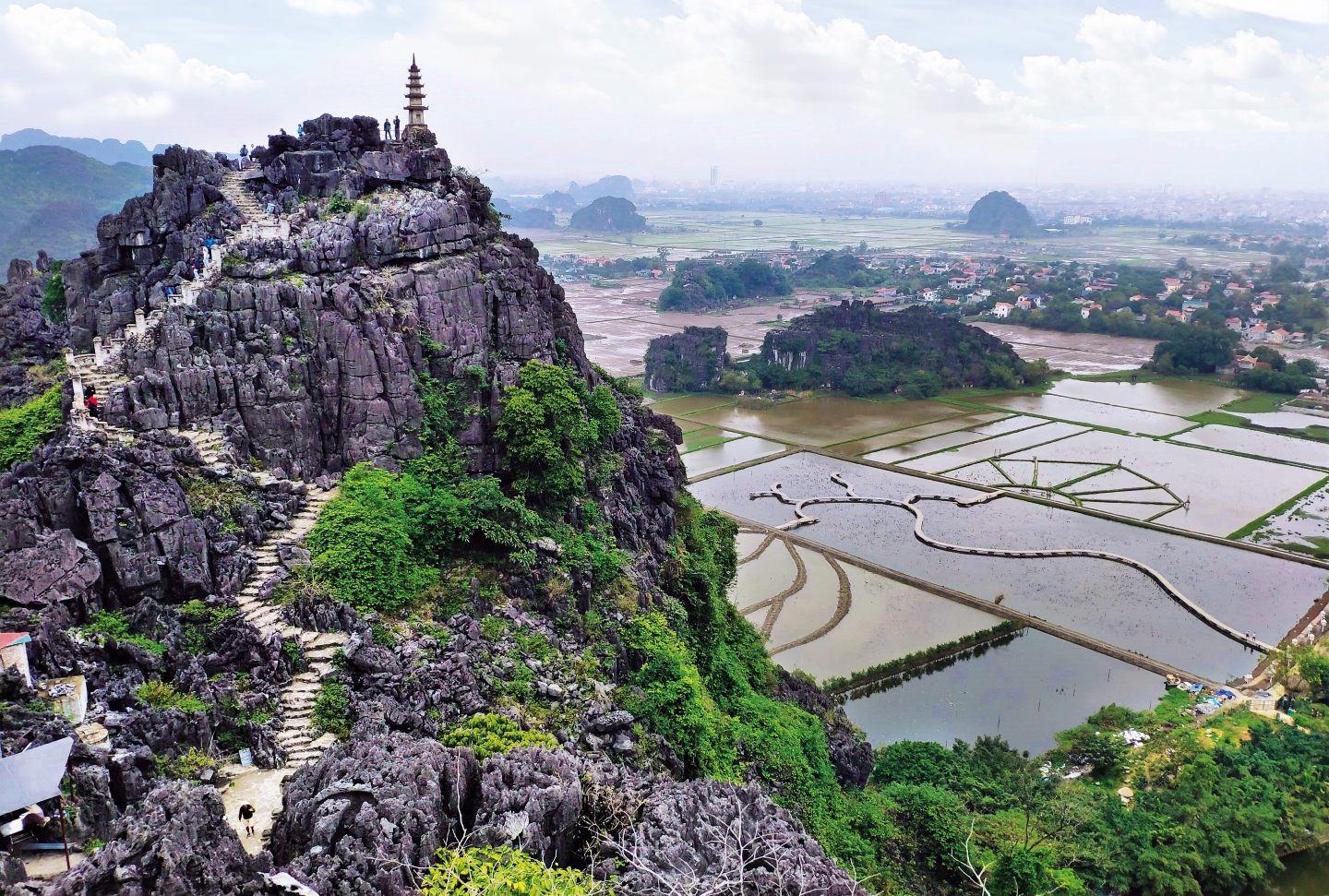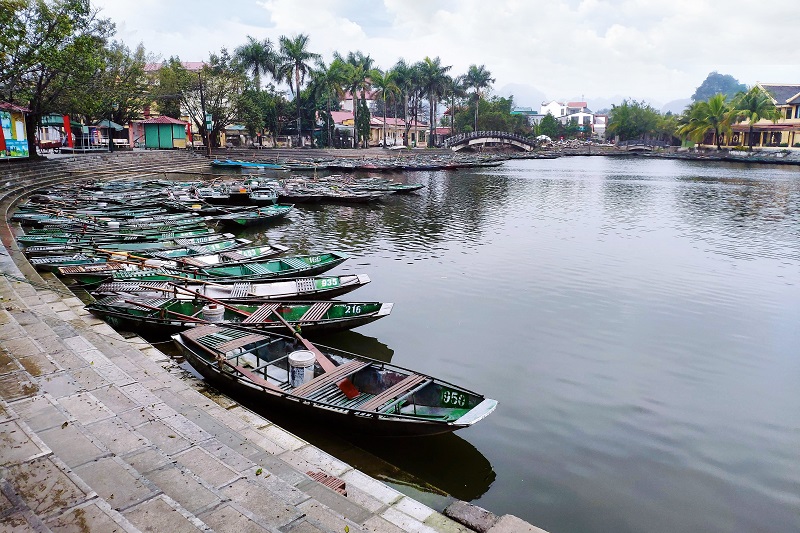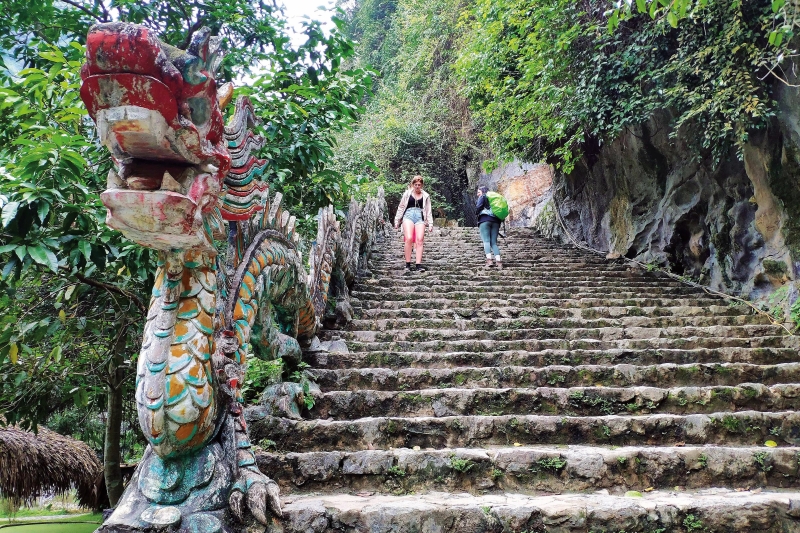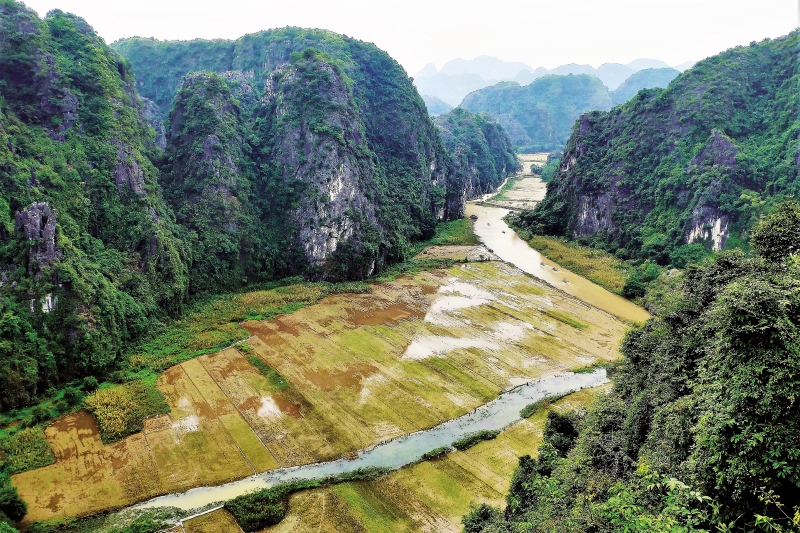
A split in the staircase leads to a small pagoda on a lower viewpoint at Hang Mua (All photos: Lee Yu Kit)
Magnificent architecture, glittering cities, adrenalin-inducing technical wizardry and towering monuments put travel destinations on the map. Ninh Binh, Vietnam, is bereft of all these. It is a rural backwater 70km south of Hanoi. What it has, it has always had: a natural landscape of vertical and horizontal elements, hewn from the seabed, forged over countless millennia by forces greater than any that mankind could muster, sculpted by time and weather into a phantasmagoria of rock and water.
Called “Halong Bay on Land” (Halong Bay being Vietnam’s famous karst landscape at sea), it has been imprinted with human activity, for which there is archaeological evidence going back some 30,000 years.
Vietnam’s ancient capital, Hoa Lu, was here in the 10th and 11th centuries before relocating to present-day Hanoi. Collectively, these have put the area on Unesco’s heritage list under the title “Trang An Landscape Complex”.
Ninh Binh is the name of the province and its small and otherwise anonymous capital city. A few kilometres away are the villages of Trang An and Tam Coc, the nexus of the landscape of ancient limestone hills, flooded rice fields and placid rivers.
One afternoon, I caught the train from Hanoi and alighted later at Ninh Binh city 2½ hours before catching a taxi to Tam Coc, a single road snaking past shops and restaurants, brightly lit, colourful affairs primped for the tourist trade. Nearby was the wharf on the placid Ngo Dong River.
After the continuous sensory assault of Hanoi city life, Tam Coc was a quiet dream. In that dream, I would explore some of its fantasy landscape from below, above and within.
tam_coc_wharf.jpg

Below the rock
Boat tours have sprouted into a mini village industry in Trang An and Tam Coc. The boat tour industry is well regulated, with a ticketing system, lifejackets and sturdy light metal vessels.
Local villagers operate the boats, rowing not with their arms but with their legs. It seemed odd to have the rower splay his limbs towards me and then curl them back with some dexterity to pull the oars back for the recovery stroke before thrusting and splaying his legs yet again. But after a while I became immersed in the scenery.
What scenery it was! It was like stepping back into a time before humans and their glittering cities of skyscrapers, when the only giants were mammoth crags of rock, cloaked in dark mats of verdure and soaring to the sky.
Human elements were shrunken to insignificance among these colossi in their indecipherable silence. We floated down the quiet river, seemingly intruders in an alien world. Through it all, my navigator and oarsman energetically rowed away with his legs.
Tam Coc means “three caves”. We glided silently, like a water insect, to a towering massif with vertical sides of melting rock. At its base, we slid into a dark cleft above the waterline and entered the submerged cave, its low ceiling pock-marked and scalloped by water over eons. We drifted silently in darkness, just briefly, and exited where the river flowed, through the other side.
river.jpg

We emerged into a hidden world concealed by mountainous limestone sentries. Above was the blue of an open sky. Beside the river were flooded paddy fields, green with newly planted saplings that would turn into fields of gold during the harvesting season.
It would not have been out of place to see hulking, stalking dinosaurs, but instead, wading water birds picked daintily in the shallows. Higher up on the rugged cliffs, small white moving objects were mountain goats perched on fingers and outcrops of rock. Was it a coincidence that the special food of the area was grilled goat meat with crispy rice?
We glided into Hang Ha, the second cave, broader and shorter than the first, emerging again into bright sunlight and an open sky — yet another chapter of this hidden environment.
The last of the three caves, Hang Ba, was the longest, its dark tunnel-like passage with a bright light at the end seemingly a rebirth into yet another world. Pockets of lights lit up sections of the ceiling, its internal folds and crevices like the insides of an enormous intestine.
At the furthest point of the ride, the oarsman deftly executed a U-turn, and we headed back towards Tam Coc. The boatman pointed to one of the limestone hills. At the very top, I saw the undulating silhouette of a dragon riding the rocks and a white pavilion nearby.
We returned to the wharf, almost rudely beckoned into the familiar world again, having been cast adrift into the dreamy landscape.
ascending.jpg

Above the rock
I borrowed a creaky bicycle from the hotel. There was little traffic on the narrow roads. A breeze sprang up, whipping leaves across my path. I rode on small country roads, past village scenes: schoolchildren spilling out of school; small, neat shops; villagers selling bottles of gasoline by the roadside.
Five kilometres from Tam Coc, the road ended at a cliff of vegetation-covered rock rising high above, with a cluster of buildings at its base — small restaurants, a resort with landscaped gardens, and a ticketing booth for entry to the Hang Mua Caves.
Hang Mua Cave was a short, airy tunnel leading to a garden. What beckoned were the rough stone steps that wound steeply up the limestone hill.
They were uneven in spacing, height and shape as I ascended the approximately 500 steps to the top, pausing now and then to look back at the increasingly spectacular panoramas. Finally, I stood at the base of the small pavilion I had seen that morning, for a completely different perspective from above, instead of being below the rock.
A white, life-sized Guan Yin (Goddess of Mercy, Avalokitesvara Boddhisattva) statue stood in the pavilion, serenely surveying her domain below. To one side stretched paddy fields, broken by occasional great dark islands of limestone hills, to a horizon of a distant cluster of buildings that was Ninh Binh city.
ngo_dong_view.jpg

Below, the pattern of paddy fields seemingly washed up against the beachhead where the clusters of limestone hills began. They held their line as they had since time immemorial, stoic, silent sentinels looking towards the sky, their vegetation-shrouded limbs and towering massifs sheltering the ancient world hidden in their bosom.
Behind were rows and rows of jagged ranges of hills, and interspersed among these massifs, far below, was the placid Ngo Dong River and its system of flooded fields. There were small boats on the river; it seemed incredible that I had been in one just a few hours earlier.
On a cairn of jagged rocks above the pavilion was the dragon, once alight in fiery colours, now the shade of time-worn stone, flecks of remnant paint clinging to its sides, its sightless eyes dark bulging orbs.
I looked upon a natural world created aeons ago when it was submerged under the sea, when uncounted numbers of marine creatures lived and died, their exoskeletons piling one upon the other, and in infinitesimal steps, compacting to form the limestone rock that, for millions of years, continental tectonic plate movement and the weather had sculpted into this fantastic landscape.
They exerted a powerful pull on the imagination of the people who lived here, as great mountains always have in every part of the world. In their strange shapes, crevices and folds dwelt demons and deities, for they expressed in stone what the human mind could only imagine.
vietnam.jpg

Into the rock
Eight kilometres away, back past Tam Coc village, I stopped at the end of the road, at a small village embraced by the limestone cliffs that rose around it.
In the 14th century, monks built a pagoda into the limestone cliff. It was an unusual pagoda. The Bich Dong pagoda has three tiers, linked to each other by steps and passages in the limestone hill. Set into the weathered rock, the three wooden temples — the Ha (lower), Trung (middle) and Thuong (upper) pagodas — were graceful but looked aged and timeworn. Within their dim interiors, golden statues gleamed and incense smoke curled past elaborate pillars and rich tapestries.
Each pagoda ascended to a different level, nearer to the sky; the highest temple was also the smallest, enclosed in a niche of protective rock where the Earth God and Mountain God reside, surveying their earthly domain.
I came away from Tam Coc with a renewed appreciation of the landscape, so often transformed by humans for dwelling, cultivation or transport, blasted into submission by industrial earth-moving equipment, and stripped of its original character.
Ninh Binh proved a counterpoint. The natural rock formations, amidst the rivers and verdure, came alive, releasing the human spirit to soar, admire and wonder, and the imagination to drift over the strange shapes and find impossible worlds within.
This article first appeared on Jan 22, 2024 in The Edge Malaysia.


